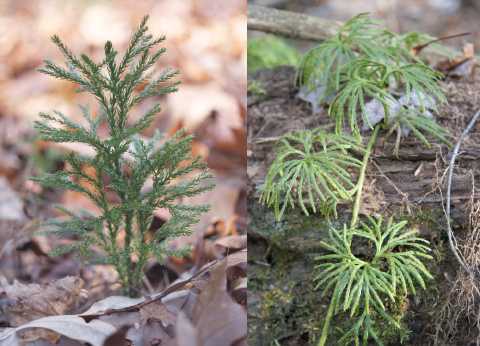

PHOTO COURTESY OF GARRY KESSLER
At left, Princess pine looks like a miniature pine tree. It's a clubmoss, an ancient group of plants that had its heyday long before there were pines, dinosaurs, or flowering plants. At right, Ground cedar is also called fan clubmoss because of its fan-like branches. It grows from a creeping stem at the soil surface.
February 17, 2006, Page 22
NATURE NOTES
By ANNIE REID
Westborough Community Land Trust
Ancient evergreens under the snow
Before last weekend's snowfall, what was green on the ground in the snowless winter woods? A surprising number of small evergreen plants grow in Westborough's woods, and one of them is princess pine.
When you see something that looks like a miniature pine tree at your feet, you're probably looking at princess pine (Dendrolycopodium obscurum or Lycopodium obscurum) also called ground pine. These small, tree-shaped plants are evergreen, with tiny leaves that seem like needles. These native plants may grow 6 to 10 inches tall. Another more descriptive name for them is flat-branched tree clubmoss.
Looks can be deceiving. Princess pine is not a pine at all. Instead, it belongs to an ancient group of plants called clubmosses, which existed before pines and before flowering plants. Princess pine doesn't flower and doesn't even produce seeds. Rather, it reproduces by spores, and often spreads by underground runners.
Long before the dinosaurs reigned, ancient relatives of princess pine and the rest of today's clubmosses grew to giant sizes. Fossils tell us that ancient tree clubmosses grew as much as 130 feet tall and 5 feet around. Along with giant tree ferns, they flourished in swamp forests in the warm, moist climate of the coal age, or Carboniferous era, 360 - 286 million years ago.
Ancient relatives of princess pine brought us one of today's key energy sources—coal. As the giant clubmosses died, they sank to the bottom of the swamps and were eventually buried and compressed by layers that covered them. Along with ferns, they were transformed by heat and pressure into the extensive coal beds that are mined today.
The giant clubmosses died out long ago, but we can enjoy princess pine year-round along cool, wooded trails right in Westborough. You can find it at the Bowman Conservation Area, especially along the first part of the trail that follows the stream from Bowman Street to Sandra Pond. You can also see it at the Headwater Conservation Area and near other trails around Mill Pond, and in many other parts of town.
People have put princess pine and related clubmosses to various uses in the past. Not surprisingly, these plants were popular as Christmas decorations, especially in wreaths, but their dust-like spores proved especially useful in other ways.
Because the spores are oily and water-repellent, they worked well as powders to soothe chafed skin and protect wounds. Large quantities of the spores were also once used to coat pills to keep them from sticking together.
In the early days of photography, the spores had a very specialized use: as flash powder. When ignited, the dry, flammable spores would explode in a brilliant flash of light. They are still sometimes used in this way in science demonstrations.
If you'd like to see these famously useful spores, the best time is in the fall. That's when princess pine and some other clubmosses produce "clubs" that shed spores to the wind. These clubs are the "club" in "clubmoss". The branches of princess pine bear upright yellow or tan "clubs" about an inch long. If you touch one of these clubs, you'll probably get powdery yellow spores on your fingers. In the winter, you may still find some plants with dried clubs containing spores.
The clubs are even more obvious on another common clubmoss called ground cedar (Diphasiastrum digitatum or Lycopodium digitatum). These small plants bear two to four clubs on stalks in a candelabra arrangement.
You'll often find ground cedar with its little candelabras in the same vicinity as princess pine. It, too, is evergreen, but its branches and leaves are flat and cedar-like. It has a very different look—not like a little pine tree—but quite lovely. Another name for this native plant is fan clubmoss.
Both princess pine and ground cedar look as if they would make attractive ground covers, but they are difficult to transplant and cultivate. In the woods deer generally don't eat them. Princess pine plants—but not their spores—contain toxic chemicals.
As you might guess from looking at them, princess pine, ground cedar, and other clubmosses aren't mosses, in spite of the "moss" in "clubmoss." Clubmosses arose after mosses in the history of life. Unlike mosses, clubmosses have the advantage of specialized tissues to transport water and sugars, so they are able to branch and grow taller. This height helps them to compete with mosses and other plants for sunlight.
Another native plant of our woods has a name that's similar to princess pine yet different: prince's pine (Chimaphila umbellata), also known as pipsessewa. It is a flowering plant with whorls of long, shiny, dark evergreen leaves. Its waxy blossoms appear in the summer.
Once the snow melts, keep an eye out for these native evergreen plants, and others, in our woods. When you look at princess pine and ground cedar, think of the coal that once heated some of Westborough's homes, thanks to the ancient relatives of today's clubmosses.
Nature Notes follow-up: Before the latest snow, Westborough's landscape was just beginning to show some early signs of spring. Like the daffodils poking up in some of our gardens, skunk cabbage was just beginning to come up in some swamps. Pussy willows were almost in bloom in some places. And at least one flock of robins came through Westborough.
Date index
Month (February)
Common name index
Scientific name index
Category index